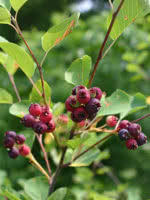Mon-Fri 9am - 5pm Mountain time
Black Elderberry vs Honeywood Saskatoon (Serviceberry)
Sambucus canadensis
Amelanchier alnifolia Honeywood
NOT AVAILABLE THIS SEASON - MIGHT RETURN
NOT AVAILABLE THIS SEASON - MIGHT RETURN
Black Elderberry is a deciduous shrub native to eastern North America. You can plant this shrub in moist areas and it will help stabilize your soil. You can also use it on rural properties anywhere you'd use a lilac.
Black Elderberries are considered to be partially self-pollinating. So while they will still produce some berries without cross-pollination, planting with another variety will increase yields. Consider planting with Ranch Elderberry or Bob Gordon Elderberry.
Warning: the seeds, stems, leaves, roots, and uncooked berries of the Black Elderberry are poisonous to humans when eaten in quantity. You should cook the berries to make them safe for human consumption.
Honeywood Saskatoon, also known as Serviceberries, is excellent at producing an abundance of blue-coloured berries in mid-summer and has dark green foliage that turns yellow in the fall. It is quite large making it a perfect shrub in your backyard garden. Often grown for its edible qualities, the Honeywood Saskatoon is quite ornamental with stunning white blooms in the spring.
Black Elderberry Quick Facts
Honeywood Saskatoon (Serviceberry) Quick Facts
Toxicity: leaves, stems, and uncooked berries are poisonous to humans

